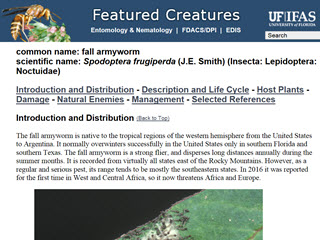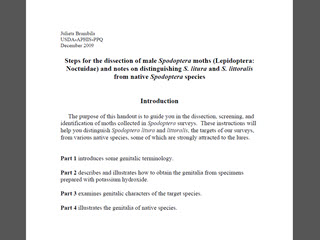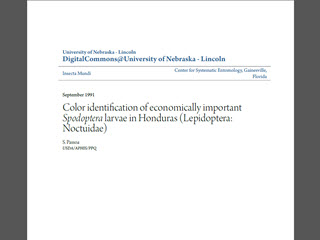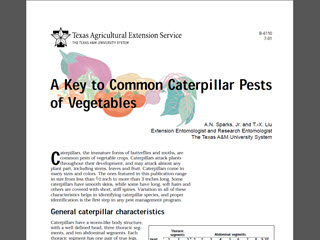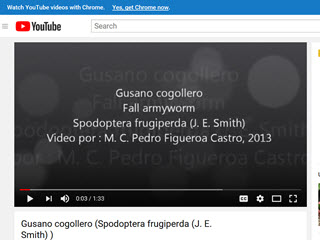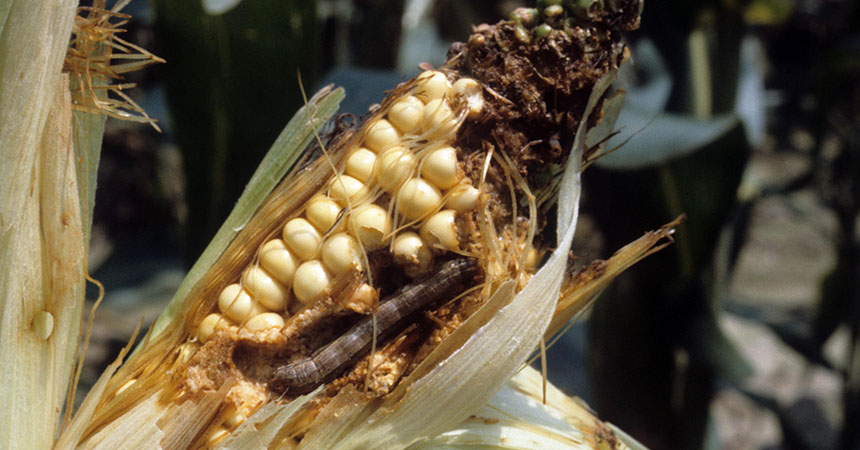
IDaids supporting identification of the fall armyworm
The fall armyworm (Spodoptera frugiperda) is native to warm regions of the Western hemisphere. In the United States, ideal climates in the southern regions of Florida and Texas provide overwintering habitat, allowing for three or more generations a year. The moths are swift and strong fliers; every state east of the Rocky Mountains has reported the pest at one time or another. The name “armyworm” refers to the speed and voracity at which caterpillars consume host plants. Particularly when ideal conditions are present, armyworms disperse in large numbers, moving from one crop to the next and consuming nearly all the plant material in their path. The fall armyworm prefers field crops like alfalfa, barley, and corn, but it also feeds on other crops, such as tobacco, apple, cabbage, and several types of flowers.
In Africa, it has rapidly spread to 26 countries since it was first reported in 2016. The Food and Agriculture Organization of the United Nations expressed concern at an Expert Meeting in September about this caterpillar's great potential to create or compact a devastating biosecurity threat, as hundreds of millions of people are dependent upon maize as a food staple.
Managing Armyworms in Pastures and Hayfields
University of Arkansas Extension, United States of America
Fact sheet comparing the morphology and life cycles of Pseudaletia unipuncta and Spodoptera frugiperda and the damage they cause.
Featured Creatures - Fall Armyworm - Spodoptera frugiperda (J.E. Smith) (Insecta: Lepidoptera: Noctuidae)
University of Florida, United States of America
A detailed fact sheet that features great images of the pest in all its life stages, including adult male and female.
Steps for the Dissection of Male Spodoptera Moths (Lepidoptera: Noctuidae) and Notes on Distinguishing S. litura and S. littoralis from Native Spodoptera Species
United States Department of Agriculture (USDA)
This handout explains how to use male genitalia to screen, dissect, and identify Spodoptera species collected from field surveys. A genitalic terminology diagram in Part 1 is followed by an illustrated step-by-step guide and comparison of genitalic characters among species.
Color Identification of Economically Important Spodoptera Larvae in Honduras (Lepidoptera: Noctuidae)
University of Nebraska Lincoln, United States of America
This publication features illustrations and photos of typical and unusual color forms of Spodoptera larvae. See details about S. frugiperda on pages 187, 191 and 193. Also includes a key to separate Spodoptera from other common pest noctuids and a key to common Spodoptera larvae.
A Key to Common Caterpillar Pests of Vegetables
Texas A&M University Extension, United States of America
This key is useful for caterpillar pests found in Texas, of which there are many. It includes a glossary of terms, images of key characters, and, for each pest, a description and image organized by family.
Gusano cogollero (Spodoptera frugiperda)
Figueroa Castro, P.
A brief video (audio in Spanish; text in English) showing the pest and damage it causes on corn.
Fall Armyworms: Identification, Damage Indications and Control
Noble Research Institute, United States of America
A more comprehensive video that presents this pest's life cycle, larva, damage, and management.

